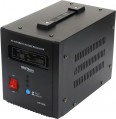Input voltage range
The voltage range at the input of the stabilizer, at which it is able to operate in normal mode and supply a constant voltage of 230 or 400 V to the load (depending on the number of phases, see above). The wider this range — the more versatile the device, the more serious power surges it can extinguish without going beyond the standard operating parameters. However, note that this parameter is not the only, and not even far from the main indicator of the quality of work: a lot also depends on the accuracy of the output voltage and the response speed (see both points below).
Also note that some models may have several modes of operation (for example, with 230 V, 230 V or 240 V output). In this case, the characteristics indicate the "general" input voltage range, from the smallest minimum to the largest maximum; the actual ranges for each particular mode will vary.
In addition, there are stabilizers that can operate outside the nominal input voltage range: with a slight deviation beyond its limits, the device provides relatively safe output indicators (also with some deviations from the nominal 230 or 400 V), but if the drop or rise becomes critical, it works appropriate protection (see below).
Cooling
The method of heat removal from the heating elements of the stabilizer.
— Passive. Passive cooling is any type of cooling that does not provide forced heat removal and is carried out only due to natural heat transfer and convection. In low-power stabilizers of this type, the cooling system as such may be completely absent — the amount of heat generated is relatively small, and the natural thermal conductivity of the case and the parts themselves is quite enough to dissipate it into the environment. In more advanced models, radiators can be installed. The main advantage of any passive cooling is the complete absence of noise. In addition, such systems are inexpensive, do not consume energy, take up relatively little space and are very reliable — there is simply nothing to break there, in most cases. On the other hand, they are significantly inferior to active cooling in terms of efficiency, and therefore are poorly suited for powerful devices, especially thyristor and triac (see "Type").
— Active. Active cooling involves the forced removal of heat from the components of the device. This is usually done by combining heatsinks with fans that "blow" excess heat out of the case. Such systems have extremely high efficiency, they can be used in stabilizers of any power, and for semiconductor models (see "Type") active cooling is simply irreplaceable. However, the cost of this efficiency is a high noise level, as well as significant dimensions and weight, which ac...cordingly affect the entire device. Fans tend to draw dust into the case, so you need to monitor them and periodically clean the “hardware” of the stabilizer; and if the fan fails, all cooling, in fact, fails. In addition, the cost of such systems is significantly higher than that of passive ones.

